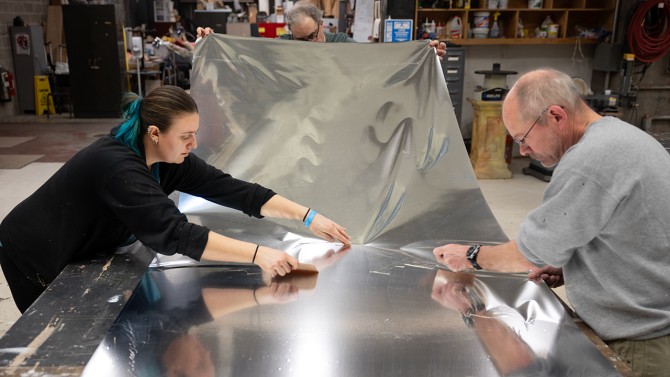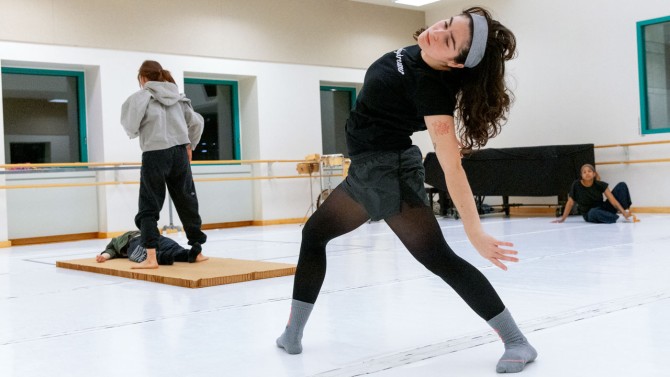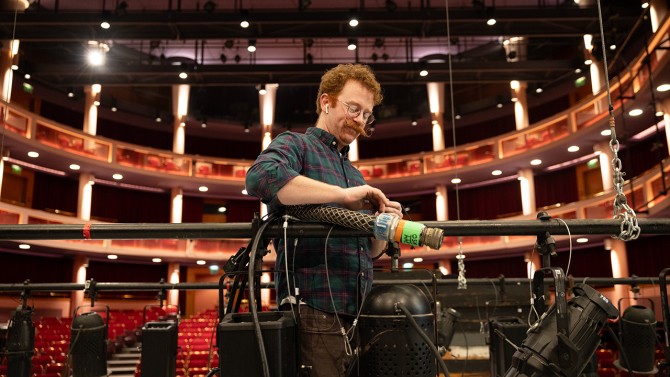“The world begins at a kitchen table,” poet laureate Joy Harjo wrote.
Inspired by this line, a kitchen table appears at the center of a live dance performance – which is paired with an exhibition of dance-related visual art – April 25-27 at the Schwartz Center for the Performing Arts. Student-artists will reimagine the Kiplinger Theater in the evening-length work, titled “This table has been a house in the rain,” through choreography and improvisation, innovative staging and ties to other art forms.
Fritz Bernstein, technical director, and Savannah Relos, assistant technical director, both in the Department of Performing and Media Arts in the College of Arts and Sciences, apply a reflective surface to a stage that will be installed in the Kiplinger Theater as part of the dance performance.
All performances are free and open to the public. The Kiplinger doors will open at 7 p.m. for a pre-show observation leading up to the live performances beginning at 7:30 p.m. Audiences are invited to experience the multimedia installation in the Schwartz Center atrium directly following the main stage event.
The culmination of a yearlong initiative, the Choreographing Justice Series, the performance is part of Cornell’s Freedom of Expression year.
“Through this student-driven project, we worked together to create a supportive space to examine, engage and make in response to individual and collective interpretations of ‘freedom of expression,'” said Danielle Russo, professor of the practice in performing and media arts in the College of Arts and Sciences (A&S), faculty lead of the stage project. “How can the kitchen table be a metaphor for each student to feel that they in fact have a place at the table? What does it mean to gather – and to also have the courage to walk away when, as Nina Simone said, ‘love is no longer being served?’ What does it feel like to have all your cards on the table and to be exposed?”
Isabel Padilla, a doctoral candidate in performing and media arts, dances in the foreground while Eliza Salamon ’24 (lying down) and Irene Kim ’24 interact with a set piece, central to the performance, representing a kitchen table.
In creating the work, students drew on personal experiences and collective actions to understand free expression in the language of movement.
“Dance can be an entry point into social, political and cultural issues or conversations,” said Isabel Padilla, a doctoral student in performing and media arts whose dance research explores performance as protest. “We’ve included both choreographed movement and improvisation in the performance piece. I think there’s room for both. Choreography can be a method of protest, and all protests are choreographed: You are here, you do that. But improvisation can also be a form of freedom, as well, because you’re using your own movement vocabularies to say something that’s true to yourself within that moment.”
Padilla said she learned about dance craft and philosophy throughout the year from Ishmael Houston-Jones, Keith Hennessy and Eiko Otake, the guest artists involved in the Choreographing Justice Series. The series was curated by Russo and Juan Manuel Aldape Muñoz, assistant professor of performing and media arts (A&S).
“Much of our programming has been geared toward artists who look at movement as a means to live, work, create and engage with one another in more just ways,” Russo said. “At the heart of it is confronting and seeking to repair, rewrite and reclaim the dance archive and to amplify the voices of artists, communities, cultures, lineages and legacies that are often erased, underrepresented or misrepresented. Dance and performance can be acts of activism and also means of community building and community repair.”
Drawing on Harjo’s imagining of the world beginning at the kitchen table, from her poem “Perhaps the World Ends Here,” the students have created an original 75-minute piece in which a table is at times a gathering place, but at other times a wall, shelter, or even a place of danger.
A wide range of props includes bamboo poles that create networks among dancers. Costumes designed by Sarah Bernstein, resident costume designer in performing and media arts (A&S), draw attention to masks people wear and layers they use to cover or reveal their stories. The performance will use the Kiplinger Theater in new and unique ways on a set designed by Jason Simms, assistant professor of performing and media arts (A&S).
Michael Garrett, a lighting and video supervisor in the Department of Performing and Media Arts, secures lights on rigging that will be used in the dance performance.
Russo, Houston-Jones and Hennessy also contributed performance scores and choreographic connective tissue; Otake provided artistic mentorship.
Audience members will exit the performance through an installation of photography and video generated by students in a course called Technology and the Human Body, taught by Olive Prince, visiting lecturer in performing and media arts (A&S). The installation appears after the show to foster dialogue, conversation and community based on the shared live experience.
“It’s about the students locating their artistic voice and impetus,” Prince said. “It gives the audience another way to engage with the interdisciplinary nature of dance and the human body. We’re broadening the definition of dance. There are a lot of people in the installation who would not define themselves as dancers.”
Through its vocabulary of movement, dance is a widely accessible form of expression, Russo said: “At the end of the day, we’re all movers. We’re all choreographers who make decisions about how we navigate through the world and relate to other bodies and our environment. That’s what choreographing a dance is, making choices to produce something genuine to that moment.”
Kate Blackwood is a writer for the College of Arts and Sciences.







